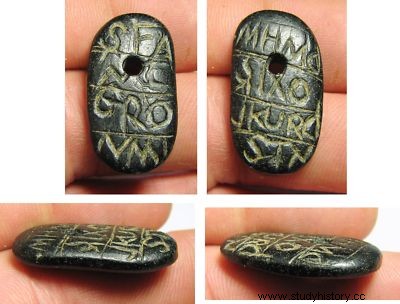When reading or hearing the expression Abracadabra we immediately think of witchcraft, enchantments, magic, and the like. Until a few years ago many magicians used it in their shows, and possibly there are those who continue to do so. The buzzword is not a modern invention, in fact neither its antiquity nor its origin is known.
Some etymologies make it derive from a Hebrew phrase that would mean I will create by speaking , others suggest that it comes from Greek, Latin or other languages, such as the Aramaic avra gavra (I will create man ), supposedly pronounced by God on the sixth day of Creation. But no documentary or archaeological evidence has been found to confirm either of these hypotheses.
But what is known is where the word Abracadabra is mentioned. for the first time. And this brings us to Rome at the end of the 2nd century and beginning of the 3rd century AD.

In the year 193 Septimius Severus ascended to power, who had two sons:Publius Septimius Geta and Lucius Septimius Basiano (better known in historiography as Caracalla). As guardian of the children, Severus appointed one of the leading scholars of the time, Quintus Sereno Sammonico.
Of Sammonico hardly anything is known about his life except for the little that is mentioned in the Historia Augusta , a collection of biographies of Roman emperors possibly written in the time of Diocletian or Constantine I, but considered unreliable by historians.
He wrote several works, almost all of them lost. Some are known from mentions in writings by later authors such as Macrobius, who extensively cites the Res reconditae of Sammonico in his Saturnalia .

But there is one of his works that has come down to us practically complete. It is a medical-didactic poem in 1,115 hexameters entitled Liber Medicinalis (Medical Book), also known by the name of De medicine praecepta saluberrima , and that Sammonico wrote before AD 212, since that is the date of his death.
In the poem he collects several popular remedies, most taken from Pliny the Elder and Dioscorides (whose work would be the main pharmacopoeia manual used in the Middle Ages and the Renaissance). And also magic formulas, including, as we said for the first time, the word abracadabra , which Sammonico recommends as a cure for acute fever.
Furthermore, he recommends using it by writing the word repeatedly in a triangle, to recite the formula in a special way. He does so in chapter LII of the Liber Medicinalis , which is about the fever the Greeks call hemitritaeo (malaria):
And it is that malaria was at that time one of the main causes of death in many regions of the Empire. The distinction between medicine, magic and superstition was not as clear and evident as it is now, and for this reason ordinary people did not hesitate to use amulets like this, trusting in their healing power. It seems that even the emperor Caracalla himself wore one, which does not sound unreasonable having been a pupil of Sammonico. In any case, its use spread throughout the Roman Empire, later entering popular folklore in the Middle Ages.

Over time, the word, which originally had a magical-medical character, began to be used in popular stories for something completely different, which is the meaning or supposed utility that has come down to our days:to make something appear or disappear by means of an enchantment.
As late as 1665, during the Great Plague of London that lasted 18 months and killed over a hundred thousand people, many tried to protect themselves by writing abracadabra at the doors of their houses, as Daniel Defoe testified. Of course, it didn't work.
Originally the word abracadabra it was used by the Gnostics of the Basilidean sect to invoke the help of spirits, and thus would have been found inscribed on stone amulets of Abraxas. This sect had been founded by Basilides of Alexandria in the second century AD, and claimed to have received its doctrine from Claucias, an apostle of Saint Peter. Abraxas was the supreme being recognized by the sect and Sammonico would have been one of his followers.
Incidentally, in Sammonico's work we also find a reference to a topic that we have dealt with here before. As we discussed in the article Mithridate, the mysterious panacea invented by Mithridates to avoid dying of poison, substances called mitridate were used both in the Middle Ages and in the Renaissance. , based on a presumed recipe that would have been found in the chambers of Mithridates and that was given to Pompey.

Sammonico instead writes the following about it:
According to Augusta History Sammonico was a supporter of Geta against his brother Caracalla. Both were co-emperors from February 4, 211 AD, after the death of his father, but in December of that same year Caracalla had his brother assassinated. He then invited many of his supporters to a banquet, among which would have been Sammonico, and there he put them all to death. Caracalla then left Rome to personally lead his military campaigns, and did not return to Rome until his death in 217 AD.
